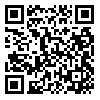Volume 7, Issue 2 (3-2020)
jbrms 2020, 7(2): 7-12 |
Back to browse issues page
Download citation:
BibTeX | RIS | EndNote | Medlars | ProCite | Reference Manager | RefWorks
Send citation to:



BibTeX | RIS | EndNote | Medlars | ProCite | Reference Manager | RefWorks
Send citation to:
Hemati S, Shams M, Rahmatian A, Nourmohammadi H, Abdoli A, Maleki F, et al . The patterns of aminoglycoside and fluoroquinolones resistance among uropathogenic Escherichia coli isolates. jbrms 2020; 7 (2) :7-12
URL: http://jbrms.medilam.ac.ir/article-1-483-en.html
URL: http://jbrms.medilam.ac.ir/article-1-483-en.html
Saeed Hemati 

 , Morteza Shams
, Morteza Shams 

 , Arash Rahmatian
, Arash Rahmatian 
 , Hasan Nourmohammadi
, Hasan Nourmohammadi 
 , Amir Abdoli
, Amir Abdoli 
 , Farajolah Maleki
, Farajolah Maleki 
 , Ghasem Talee
, Ghasem Talee 
 , Zahra Mahdavi
, Zahra Mahdavi 
 , Elham Bastani
, Elham Bastani 
 , Vahid Hatami
, Vahid Hatami 
 , Fatemeh Kohzadi
, Fatemeh Kohzadi 




 , Morteza Shams
, Morteza Shams 

 , Arash Rahmatian
, Arash Rahmatian 
 , Hasan Nourmohammadi
, Hasan Nourmohammadi 
 , Amir Abdoli
, Amir Abdoli 
 , Farajolah Maleki
, Farajolah Maleki 
 , Ghasem Talee
, Ghasem Talee 
 , Zahra Mahdavi
, Zahra Mahdavi 
 , Elham Bastani
, Elham Bastani 
 , Vahid Hatami
, Vahid Hatami 
 , Fatemeh Kohzadi
, Fatemeh Kohzadi 


Zoonotic Diseases Research Center, Ilam University of Medical Sciences, Ilam, Iran
Abstract: (2763 Views)
Introduction: In the study we sought to determine the patterns of regional antibiotic resistances among uropathogenic Escherichia coli (UPEC) isolates. Our finding could be useful for better recognition of regional antibiotic resistances and scheduling a program to control this condition.
Materials and methods: In the study, 270 nonduplicate UPEC isolates were examined from urine samples of outpatients with urinary tract infections (UTIs). All isolates were identified by gram staining and standard conventional biochemical tests. Antimicrobial susceptibility test was performed by disk diffusion (Kirby–Bauer) method. The commercial antibiotics disks (PADTAN TEB Co., Iran) were applied in the study, included amikacin (30 μg), gentamycin (10 μg), ciprofloxacin (5 μg), and nalidixic acid (30 μg).
Results: Most of the patients were female (221, 81.9%). The highest resistance was observed for nalidixic acid (56%), followed by ciprofloxacin 39.64%. In contrast, the lowest resistance was seen for amikacin (3.90%) and gentamicin (10.04%). Moreover, 19.62% of the isolates were multidrug-resistant (MDR).
Conclusion: Amikacin and gentamicin could be chosen as first line antibiotics in treatment of UTIs. Continuous monitoring studies recommended for acquire a suitable regional antibiotic resistance pattern.
Materials and methods: In the study, 270 nonduplicate UPEC isolates were examined from urine samples of outpatients with urinary tract infections (UTIs). All isolates were identified by gram staining and standard conventional biochemical tests. Antimicrobial susceptibility test was performed by disk diffusion (Kirby–Bauer) method. The commercial antibiotics disks (PADTAN TEB Co., Iran) were applied in the study, included amikacin (30 μg), gentamycin (10 μg), ciprofloxacin (5 μg), and nalidixic acid (30 μg).
Results: Most of the patients were female (221, 81.9%). The highest resistance was observed for nalidixic acid (56%), followed by ciprofloxacin 39.64%. In contrast, the lowest resistance was seen for amikacin (3.90%) and gentamicin (10.04%). Moreover, 19.62% of the isolates were multidrug-resistant (MDR).
Conclusion: Amikacin and gentamicin could be chosen as first line antibiotics in treatment of UTIs. Continuous monitoring studies recommended for acquire a suitable regional antibiotic resistance pattern.
Type of Study: Research |
Subject:
Microbiology
Received: 2020/02/11 | Accepted: 2020/05/26 | Published: 2020/03/1
Received: 2020/02/11 | Accepted: 2020/05/26 | Published: 2020/03/1
| Rights and permissions | |
 |
This work is licensed under a Creative Commons Attribution-NonCommercial 4.0 International License. |


